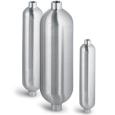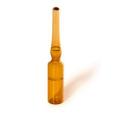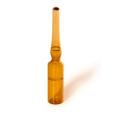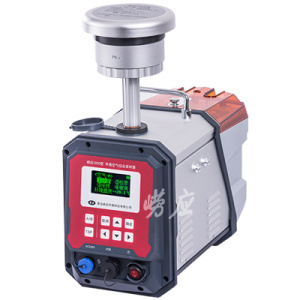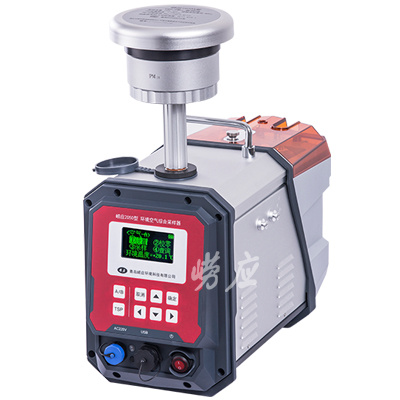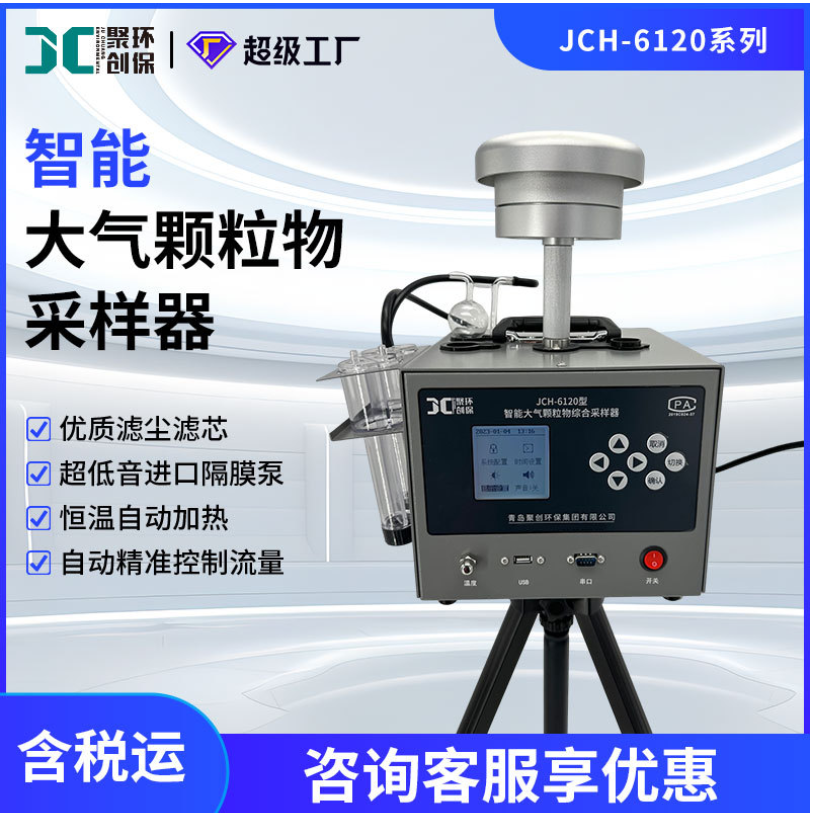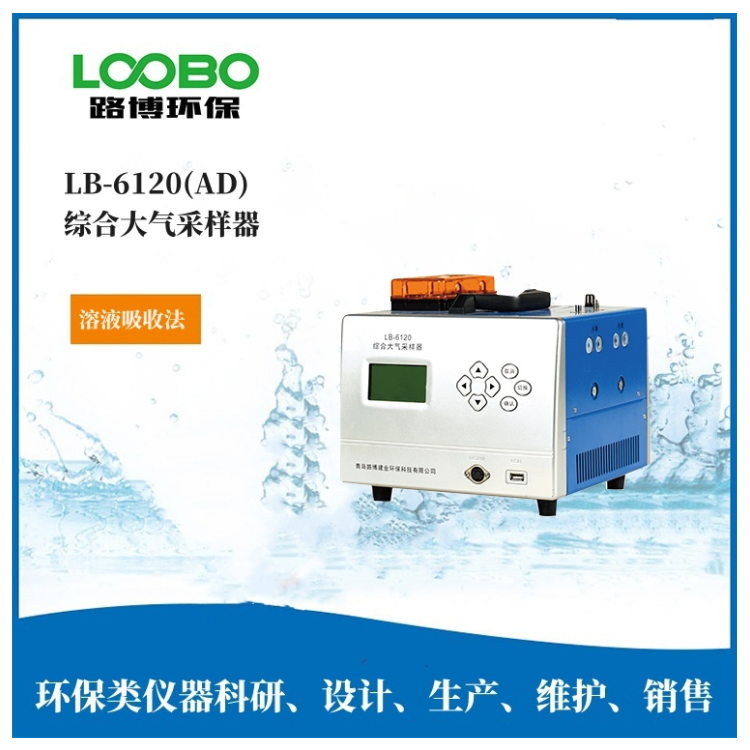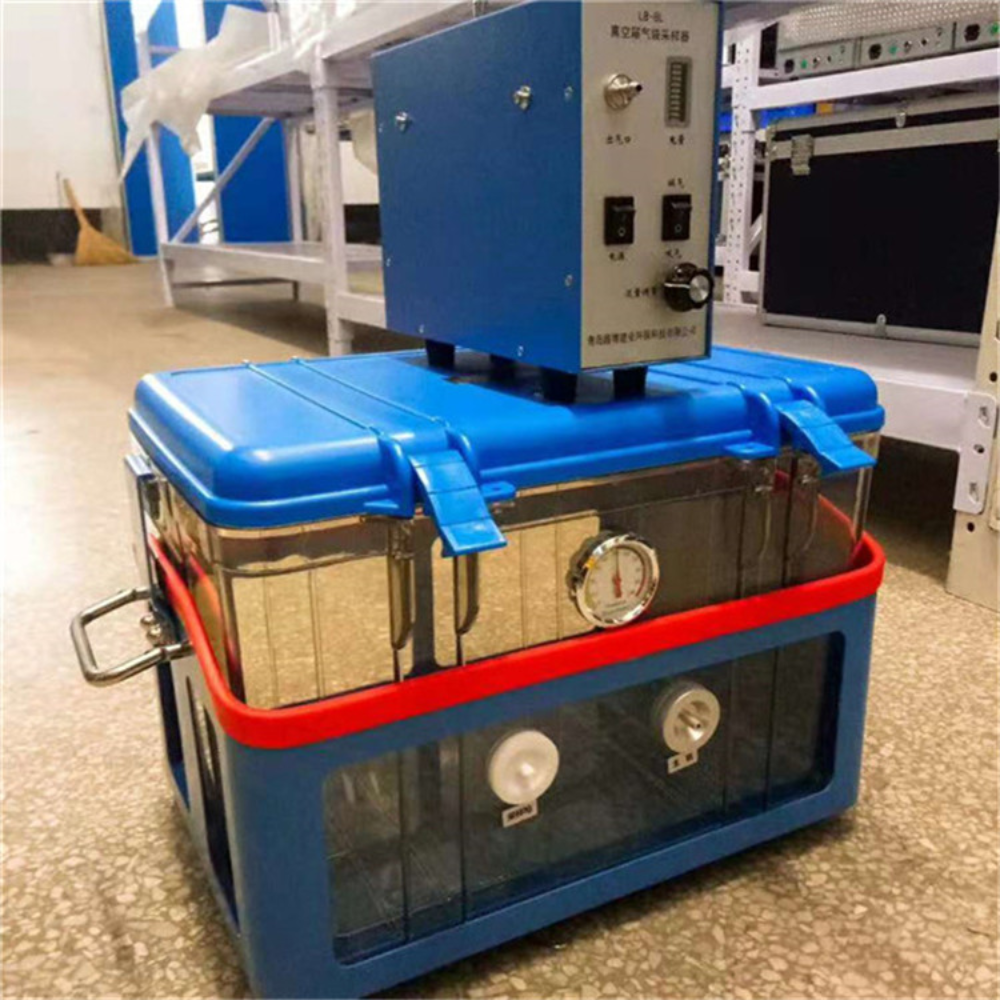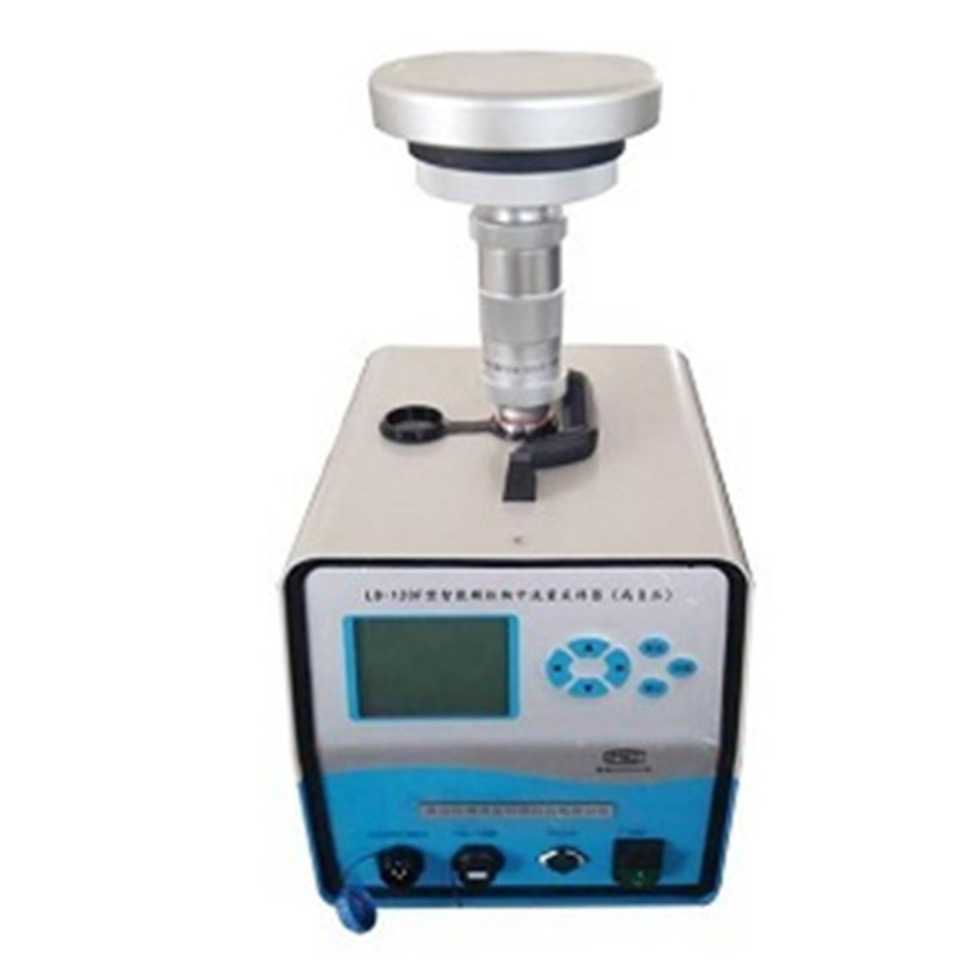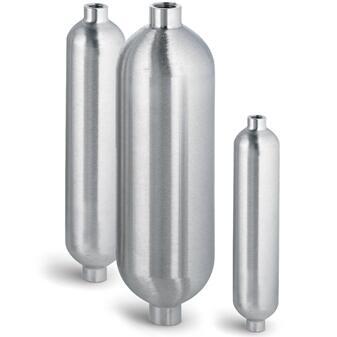
方案详情
文
基线分离确保空气样品中15种常见的醛和酮的准确测定。
•Raptor C18给你一分钟内最小样品量理想的分析结果。
•Restek®认证的参考材料是专门制定环境空气和汽车排放测试的标准耗材。空气样品中醛酮的准确分析是监测空气污染和保护空气污染的重要环节关系世界各地的人类健康。
方案详情

Featured Application:Aldehydes and Ketones in Air Samples on RaptorTMARC-18 and C18 LC Columns百道亨仪器设备(北京)有限公司 010-67968866 18911200309 QQ:2974955871thank.010@163.com ·Baseline separation ensures accurate determination of 15 commonly analyzed aldehydes and ketones in air samples. ·RaptorLC column give you results in minutes-not hours-for increased sample throughput. ·Restek° certified reference materials are specially formulated for ambient air and automotive emissions testing. Accurate analysis of aldehydes and ketones in air samples is an important part of monitoring programs that are used to control air pollution and to protecthuman health around the world. These airborne carbonyls from industrial and vehicle emissions are precursors to ozone in smog and are associated withrespiratory and pulmonary problems. In addition, specific carbonyls-formaldehyde and acetaldehyde-have been identified as known or suspectedcarcinogens. Prior to analysis, aldehydes and ketones are converted to hydrazone derivatives when they are captured on a sampling tube composed ofsilica gel coated with 2,4-dinitrophenylhydrazine(DNPH).Then, the aldehyde/ketone DNPH derivatives are eluted from the sampling tube with solvent andanalyzed by HPLC-UV. Typically, carbonyl LC methods require long analysis times (often over an hour), but many still fail to provide adequate resolution forsome aldehyde/ketone DNPH derivatives. To help labs improve analytical speed and accuracy in the analysis of aldehydes and ketones in air samples,Restek has developed LC columns,instrumentconditions, and certified reference materials that reliably provide baseline separation of commonly analyzed aldehyde/ketone DNPH derivatives in just min-utes. For example, airborne carbonyls LC method U.S. EPA Method TO-11A uses a conventional C18 column and requires an analysis time of over one hour,yet acrolein and acetone partially coelute and the o-,m-,and p-tolualdehyde isomers cannot be fully separated. In contrast,using a Raptor C18 columnunder the conditions shown below, all 15 carbonyls—including the tolualdehyde isomer cluster-are separated to baseline in a fast 14-minute analysis. Similarly, airborne carbonyl LC method CARB 1004 produces extremely long analysis times; in fact, this method requires two separate chromatographicanalyses in order to quantify all compounds. The first is a 37-minute analysis using two columns connected in series. Even with two columns and a longanalysis time, methyl ethyl ketone and butyraldehyde coelute in this analysis. To report these two compounds,another 30-minute chromatographic analy-sis with a different column is needed. However, this second analysis cannot be used to report all compounds due to the coelution of formaldehyde with anon-carbonyl compound. This same list of CARB 1004 aldehyde/ketone DNPH derivatives can be fully resolved by the second Restek° method shown belowusing a Raptor ARC-18 column in a fast 8.5-minute analysis-an 8-fold reduction in analysis time with a single column. Both of these methods from Restek are compatible with conventional 400 bar HPLC systems and benefit from the larger, low-clog frit used in RaptorMcolumn hardware. Using either Raptor LC column—along with Restek’s airborne carbonyl reference standards—assures fast, accurate analysis ofaldehydes and ketones in air and offers an opportunity for improved sample throughput compared to typical columns and methods. Time (min) Flow (mL/min) 0.00 5.00 11.00 11.01 12.00 12.01 14.00 8 0.00 1.00 2.00 3.00 4.00 5.00 6.00Time(min)LC_EV0532 7.00 8.00 9.00 10.00 11.00 12.00 0.00 0.50 1.00 1.50 2.00 2.50 3.00 3.50 4.00 4.50 5.00 5.50 6.00 6.50 Time (min) Raptor C18 LC Columns (USPL1) RaptorARC-18 LC Columns (USP L1) Description cat.# Description cat.# 2.7 pm Columns150 mm, 4.6 mm ID 9304A65 2.7 pm Columns 100 mm, 3.0 mm ID 9314A1E EXP Direct Connect Holder Description EXP Direct Connect Holder for EXP Guard Cartridges (includes hex-head fitting & 2 ferrules) 25808 Acetaldehyde-2,4-DNPH(1019-57-4) n-Butyraldehyde-2,4-DNPH (1527-98-6) Hexaldehyde-2,4-DNPH (1527-97-5) Propionaldehyde-2,4-DNPH(725-00-8) Acetone-2,4-DNPH(1567-89-1) Crotonaldehyde-2,4-DNPH (1527-96-4) Methacrolein-2,4-DNPH (5077-73-6) m-Tolualdehyde-2,4-DNPH (2880-05-9) Acrolein-2,4-DNPH (888-54-0) Formaldehyde-2,4-DNPH(1081-15-8) Methyl ethyl ketone-2,4-DNPH(958-60-1) Valeraldehyde-2,4-DNPH(2057-84-3) Benzaldehyde-2,4-DNPH(1157-84-2) 3 pg/mL each in acetonitrile, 1 mL/ampul* cat.# 33093 (ea.) Raptor"EXP° Guard Column Cartridges Particle 5x2.1 mm 5x3.0mm 5x4.6mm Description Size qty. cat.# cat.# cat.# Maximum cartridge pressure: Raptor ARC-18 EXP Guard Column Cartridge 2.7pm 3-pk. 9314A0252 9314A0253 9314A0250 600 bar/8,700 psi(2.7pm) or Raptor C18 EXP Guard Column Cartridge 2.7 pm 3-pk. 9304A0252 9304A0253 9304A0250 400 bar/5,800psi (5um). 百道亨仪器设备(北京)有限公司 010-67968866 18911200309QQ:2974955871ttlhank.010@163.com Restek@ patents and trademarks are the property of Restek Corporation. (See www.restek.com/Patents-Trademarks for full list.) Other trademarks in Restek@ literature or on its website arety:the property of their respective owners. Restek@registered trademarks are registered in the U.S. and may also be registered in other countries. o 2016 Restek Corporation. All rights reserved. Printed in the U.S.A. ISO Pure Chromatography 9001·17025·Guide 34 RESTEKPure Chromatographywww.restek.com道亨仪器设备(北京)有限公司 QQ:thank.com www.restek.comLit. Cat.#EVSSUNV • Baseline separation ensures accurate determination of 15 commonly analyzed aldehydes and ketones in air samples.• Raptor™ LC columns give you results in minutes—not hours—for increased sample throughput.• Restek® certified reference materials are specially formulated for ambient air and automotive emissions testing.Accurate analysis of aldehydes and ketones in air samples is an important part of monitoring programs that are used to control air pollution and to protecthuman health around the world. These airborne carbonyls from industrial and vehicle emissions are precursors to ozone in smog and are associated withrespiratory and pulmonary problems. In addition, specific carbonyls—formaldehyde and acetaldehyde—have been identified as known or suspectedcarcinogens. Prior to analysis, aldehydes and ketones are converted to hydrazone derivatives when they are captured on a sampling tube composed ofsilica gel coated with 2,4-dinitrophenylhydrazine (DNPH). Then, the aldehyde/ketone DNPH derivatives are eluted from the sampling tube with solvent andanalyzed by HPLC-UV. Typically, carbonyl LC methods require long analysis times (often over an hour), but many still fail to provide adequate resolution forsome aldehyde/ketone DNPH derivatives.To help labs improve analytical speed and accuracy in the analysis of aldehydes and ketones in air samples, Restek has developed LC columns, instrumentconditions, and certified reference materials that reliably provide baseline separation of commonly analyzed aldehyde/ketone DNPH derivatives in just minutes. For example, airborne carbonyls LC method U.S. EPA Method TO-11A uses a conventional C18 column and requires an analysis time of over one hour,yet acrolein and acetone partially coelute and the o-, m-, and p- tolualdehyde isomers cannot be fully separated. In contrast, using a Raptor™ C18 columnunder the conditions shown below, all 15 carbonyls—including the tolualdehyde isomer cluster—are separated to baseline in a fast 14-minute analysis.Similarly, airborne carbonyl LC method CARB 1004 produces extremely long analysis times; in fact, this method requires two separate chromatographicanalyses in order to quantify all compounds. The first is a 37-minute analysis using two columns connected in series. Even with two columns and a longanalysis time, methyl ethyl ketone and butyraldehyde coelute in this analysis. To report these two compounds, another 30-minute chromatographic analysis with a different column is needed. However, this second analysis cannot be used to report all compounds due to the coelution of formaldehyde with anon-carbonyl compound. This same list of CARB 1004 aldehyde/ketone DNPH derivatives can be fully resolved by the second Restek® method shown belowusing a Raptor™ ARC-18 column in a fast 8.5-minute analysis—an 8-fold reduction in analysis time with a single column.Both of these methods from Restek are compatible with conventional 400 bar HPLC systems and benefit from the larger, low-clog frit used in Raptor™column hardware. Using either Raptor™ LC column—along with Restek’s airborne carbonyl reference standards—assures fast, accurate analysis ofaldehydes and ketones in air and offers an opportunity for improved sample throughput compared to typical columns and methods.
确定
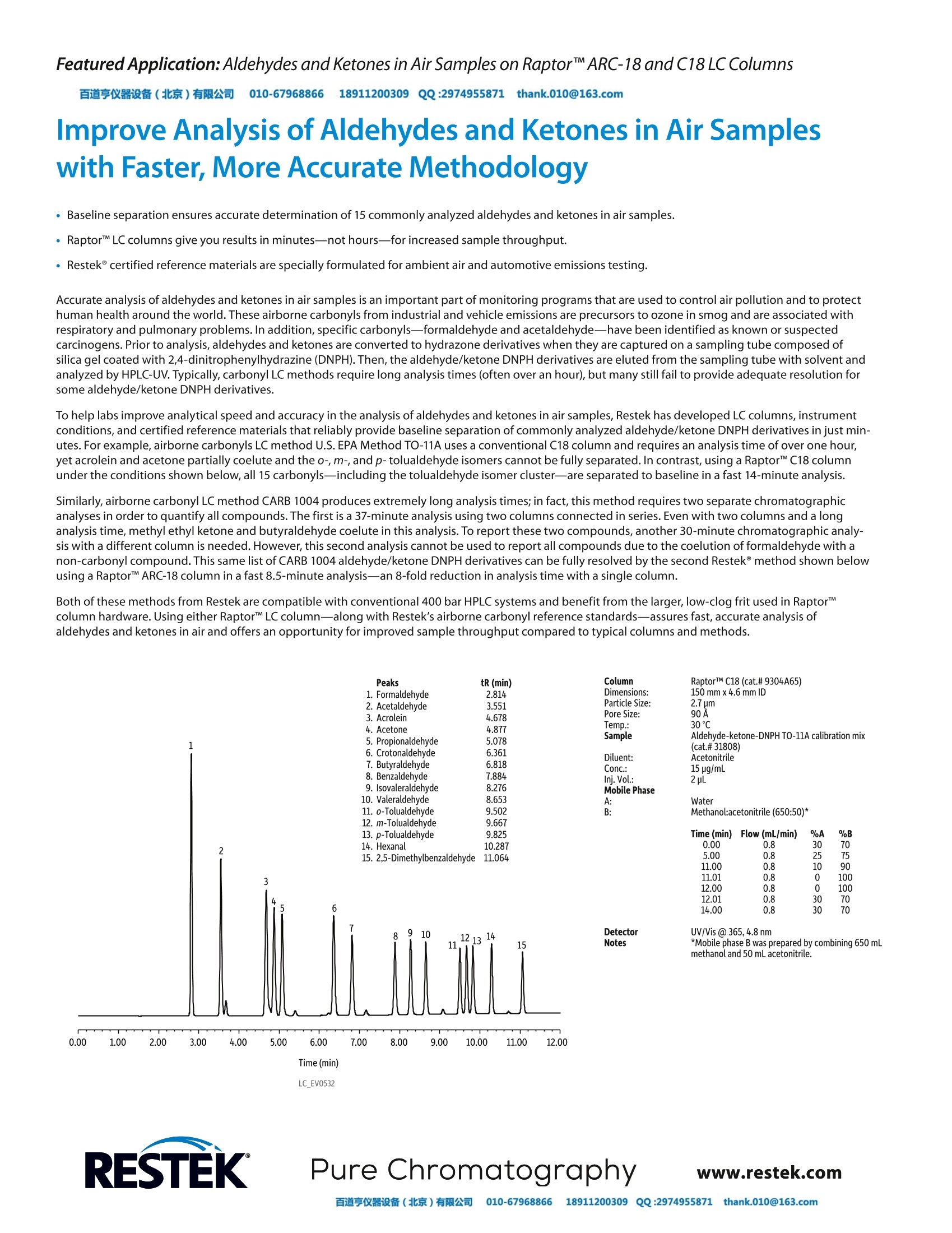
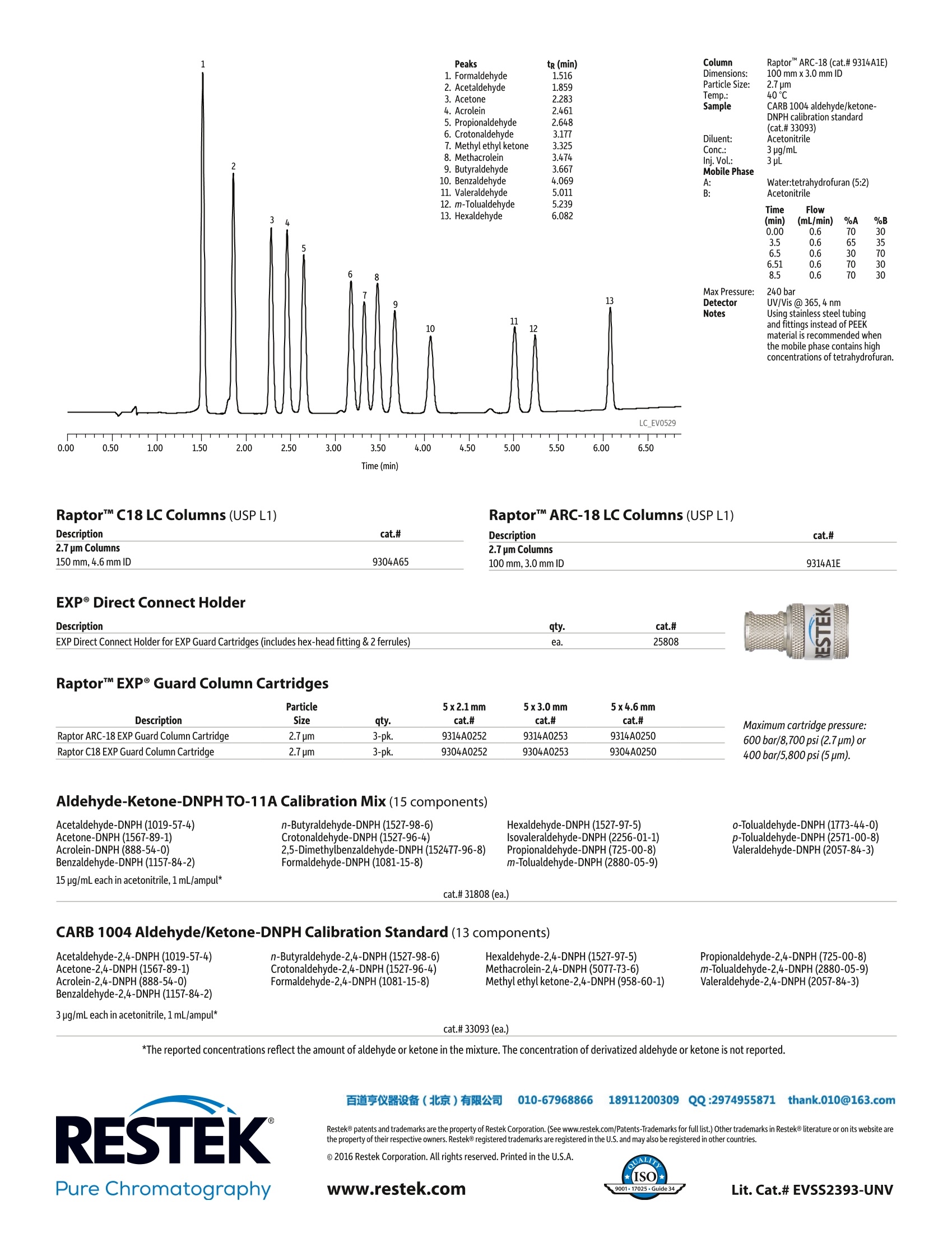
还剩1页未读,是否继续阅读?
百道亨仪器设备(北京)有限公司为您提供《空气中醛酮检测方案(液相色谱柱)》,该方案主要用于空气中有机污染物检测,参考标准--,《空气中醛酮检测方案(液相色谱柱)》用到的仪器有PTFE涂层苏玛罐 氟化采样罐、醛-酮-DNPH TO-11A校准混合物(15 种成分)、CARB 1004醛/酮-DNPH 校准标准品 (13 种成分)
推荐专场
相关方案
更多









